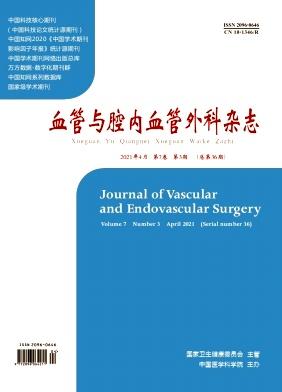Comparison of Aortobifemoral Bypass and Endovascular Treatment for Chronic Infrarenal Abdominal Aortic Occlusion From the CHAOS (CHronic Abdominal Aortic Occlusion, ASian Multicenter) Registry.
引用次数: 1
Abstract
PURPOSE To directly compare the clinical outcomes of aortobifemoral bypass surgery (ABF) and endovascular treatment (EVT) for chronic total occlusion (CTO) of the infrarenal abdominal aorta (IAA). MATERIALS AND METHODS In this retrospective, multicenter study, we used an international database of 436 patients who underwent revascularization for CTO of the IAA between 2007 and 2017 at 30 Asian cardiovascular centers. After excluding 52 patients who underwent axillobifemoral bypass surgery, 384 patients (139 ABFs and 245 EVTs) were included in the analysis. Propensity score-matched analysis was performed to compare clinical results in the periprocedural period and the long-term. RESULTS Propensity score matching extracted 88 pairs. Procedure time (ABF; 288 [240-345] minutes vs EVT; 159 [100-205] minutes, p<0.001) and length of hospital stay (17 [12-23] days vs 5 [4-13] days, p<0.001) were significantly shorter in the EVT group than in the ABF group, while the proportions of procedural success (98.9% versus 96.6%, p=0.620), complications (9.1% versus 12.3%, p=0.550), and mortality (2.3% versus 3.8%, p=1.000) were not different between the groups. At 1 months, ABI significantly increased more in the ABF group for both in a limb with the lower (0.56 versus 0.50, p=0.018) and the higher (0.49 versus 0.34, p=0.001) baseline ABI, while the change of the Rutherford category was not significantly different between the groups (p=0.590). At 5 years, compared with the EVT group, the ABF group had significantly better primary patency (89.4±4.3% versus 74.8±4.3%, p=0.035) and survival rates (86.9±4.5% versus 66.2±7.5%, p=0.007). However, there was no significant difference between the groups for secondary patency (100.0%±0.0% versus 93.5%±3.9%, p=0.160) and freedom from target lesion revascularization (TLR) (89.3±4.3% vs 77.3±7.3%, p=0.096). CONCLUSION Even with recent advancements in EVT, primary patency was still significantly better for ABF in CTO of the IAA. However, there was no difference between the groups in terms of secondary patency and freedom from TLR at 5 years. Furthermore, there was no difference in procedural success, complications, mortality, and improvement in the Rutherford classification during the periprocedural period, with significantly shorter procedure time and hospital stay in the EVT group.来自CHAOS(慢性腹主动脉阻塞,亚洲多中心)注册的慢性腹主动脉阻塞的动脉绕道和血管内治疗的比较。
目的直接比较主动脉-股动脉旁路手术(ABF)与血管内治疗(EVT)治疗慢性肾下腹主动脉(IAA)全闭塞(CTO)的临床效果。材料和方法在这项回顾性的多中心研究中,我们使用了一个国际数据库,其中包括2007年至2017年在30个亚洲心血管中心接受IAA CTO血运重建术的436例患者。在排除52例接受腋静脉搭桥手术的患者后,384例患者(139例abf和245例evt)被纳入分析。采用倾向评分匹配分析比较围手术期和远期的临床结果。结果倾向评分匹配提取88对。程序时间(ABF;288[240-345]分钟vs EVT;EVT组的住院时间(159[100-205]分钟,p<0.001)和住院时间(17[12-23]天对5[4-13]天,p<0.001)明显短于ABF组,而手术成功率(98.9%对96.6%,p=0.620)、并发症(9.1%对12.3%,p=0.550)和死亡率(2.3%对3.8%,p=1.000)的比例在两组之间没有差异。在1个月时,ABF组的基线ABI较低(0.56比0.50,p=0.018)和较高(0.49比0.34,p=0.001)的肢体的ABI均显著增加,而卢瑟福分类的变化在两组之间无显著差异(p=0.590)。5年时,与EVT组相比,ABF组的原发性通畅度(89.4±4.3%比74.8±4.3%,p=0.035)和生存率(86.9±4.5%比66.2±7.5%,p=0.007)显著提高。然而,两组间继发性通畅(100.0%±0.0% vs 93.5%±3.9%,p=0.160)和无靶病变血运重建(TLR)(89.3±4.3% vs 77.3±7.3%,p=0.096)差异无统计学意义。结论:尽管EVT在近期取得了进展,但IAA CTO中ABF的原发性通畅程度仍显著提高。然而,在5年的二次通畅和TLR自由方面,两组之间没有差异。此外,在手术成功率、并发症、死亡率和围手术期卢瑟福分类的改善方面,EVT组的手术时间和住院时间明显缩短。
本文章由计算机程序翻译,如有差异,请以英文原文为准。
求助全文
约1分钟内获得全文
求助全文

 求助内容:
求助内容: 应助结果提醒方式:
应助结果提醒方式:


